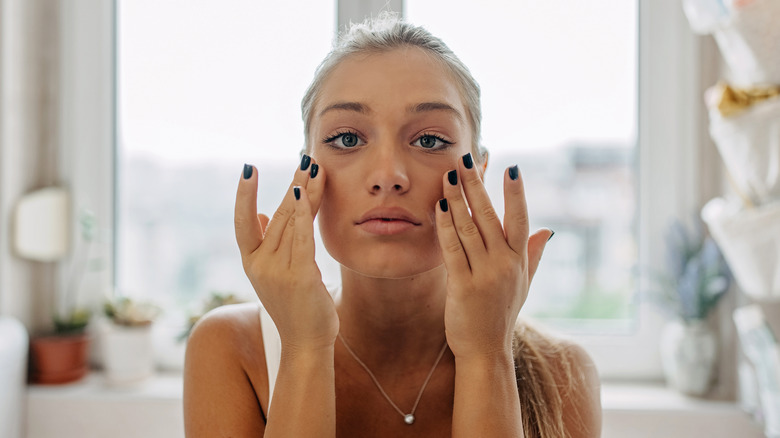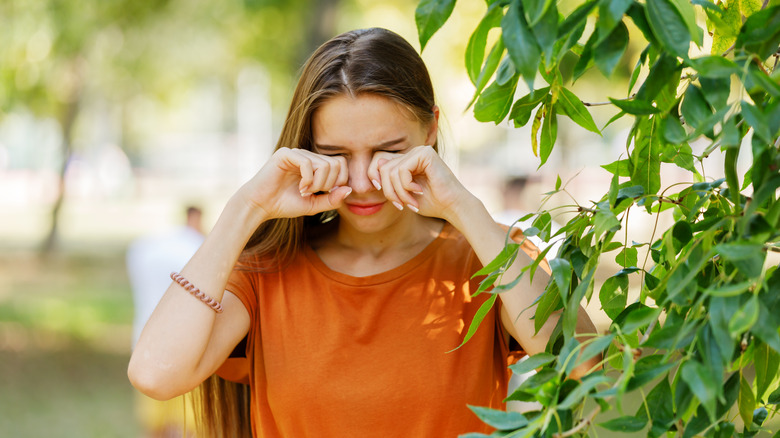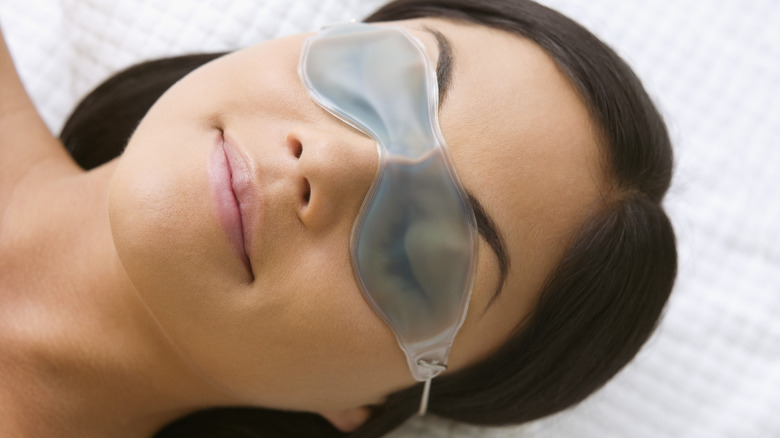What It Means When You Have Dark Circles On Your Eyelids
You're in the middle of your morning routine when you notice that you have dark circles above your eyes. Grabbing your cleanser, you try to wipe it away, thinking it might be remnants of your night out with your friends. The darkness doesn't go anywhere. Should you start to worry about the darkness around your eyes?
Hyperpigmentation is the accumulation of darker skin. It can happen anywhere on your body, but it's most noticeable on your face. Hyperpigmentation around the eyelids and under your eyes typically has several different causes. Some are natural, like genetics and sun exposure, while others come from various medical conditions.
A trip to your doctor might be warranted for treatment options, but dark eyelids aren't anything to worry about. Your fears will calm once you explore what it means to have dark eyelids. Knowing treatment and prevention options will also help to brighten your outlook.
Natural causes of dark circles on eyelids
You might be used to your undereye varying in color daily, but it can be a bit concerning when you notice dark circles on your upper eyelid. Getting dark circles on the eyelid isn't typically a cause for concern. Several natural factors lead to dark circles, like not getting enough sleep or too much alcohol the night before.
One of the most common reasons for dark eyelids is sun exposure. Exposing your skin to the sun without wearing any SPF or protection can cause areas of your skin to produce more color. The Journal of Clinical and Aesthetic Dermatology (JCAD) notes that ultraviolet radiation can aggravate periorbital hyperpigmentation (dark eyelids) and make the condition look worse. It's also common for people to be genetically predisposition to have darker skin on their eyelids. So, if you notice that your mother or father has darker eyelids, it's probably due to genetics.
Age also plays a factor in the dark circles on your eyelids. As the body starts to lose collagen and the skin gets thinner, it can cause the eyelids to look darker due to the underlying vessels.
Medical conditions that cause dark eyelids
Sun and genetics are common causes of those dark circles you're sporting, but they also might have a medical component. The JCAD notes that hyperpigmentation of the eyes can be due to inflammation: Allergic dermatitis, eczema, allergies, and other chronic skin inflammation cause swelling and itching. The rubbing, scratching, and swelling create a brownish or grayish tinge to the lid.
You might also experience dark eyelids due to being pregnant. As your hormones shift, you can get darkening of the skin, known as "melasma," according to Healthline. Melasma during pregnancy doesn't just affect the eyes, though; it can also affect other areas of your face. So, you might notice a darkening of the skin around your lips or develop dark patches on your cheeks in addition to the dark circles above your eyes. The good thing is that this hyperpigmentation typically clears up once you deliver.
The JCAD also notes that the drugs you take for glaucoma might be to blame for the darkness of your eyelids. The research report states that prostaglandin analogs create hyperpigmentation around the eyes about 3-6 months after the therapy begins. However, it can go away once the medication is discontinued.
How to treat dark circles on eyelids
Once you identify the cause of your dark eyelids, it's all about finding a treatment method that can work for you. The treatment is going to vary slightly depending on the cause. Environmental and lifestyle factors might respond well to home treatments, like getting enough sleep and watching your diet. Just like under your eyes, dark circles on the upper lids can react well to cold compresses, according to Medical News Today.
Medical reasons for your hyperpigmentation might require a more invasive treatment method. The JCAD notes that doctors might try topical creams that help to reduce the melanin within the skin to give a lighter appearance to your lids. They might also try bleaching agents like hydroquinone to remove the discoloration. Creams designed to handle hyperpigmentation on the face, like vitamin C or azelaic acid, can also be helpful with the condition. Treating the underlying condition, such as allergies or inflammation, reduces the darkness of the circles. Depending on the severity and amount of emotional distress the condition causes, more invasive treatments, like laser therapy, chemical peels, fillers, and surgery, might be in order.
Talking to your healthcare specialist or dermatologist is vital to finding the proper treatment method to treat the cause and getting the best results.
Effective ways to prevent dark circles on eyelids
Prevention can be the best medicine for dark spots on your skin. Medical News Today notes that the sun is a common contributor to hyperpigmentation, so choose skin care creams and primers with some SPF in them. You might also want to use a concealer with a bit of SPF. This can help to ensure that the delicate lids of your eyes are covered. Use sun protection, like wearing a hat or sunglasses, to avoid getting too many rays. Also, consider limiting your time in the sun, especially if you know you are prone to dark circles on your eyelids.
Avoid rubbing the eyes and make sure to take your medication for allergies regularly to help prevent darkness due to inflammation. Also, follow up with your healthcare provider and get certain conditions checked to ensure they don't cause damage to your eyelids. Think about changing your diet or sleeping habits if you notice that the darkness comes after a salty meal or a night of drinking. If in doubt, add a little concealer to cover it up and boost your confidence.
Dark circles on your eyelids can come from several causes, but most are just cosmetic blemishes. However, if the circles affect your self-esteem or self-image, several treatment options are available to lighten your eyes.





